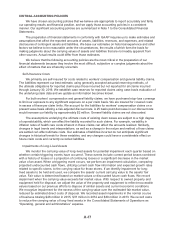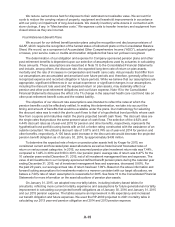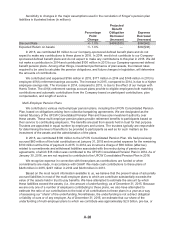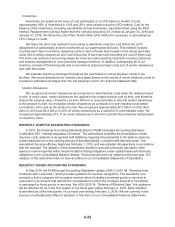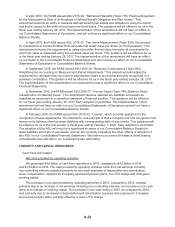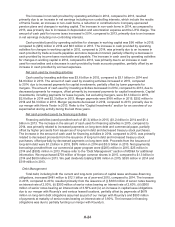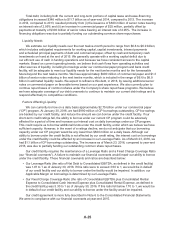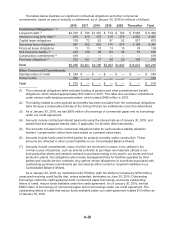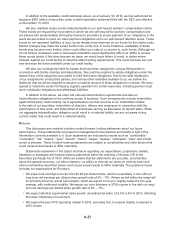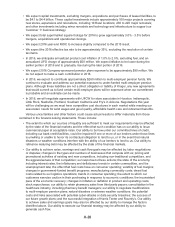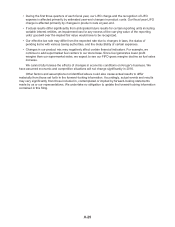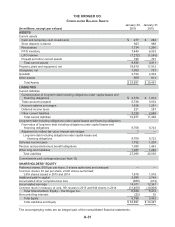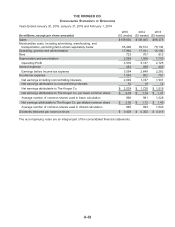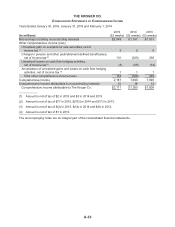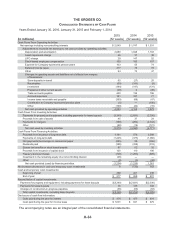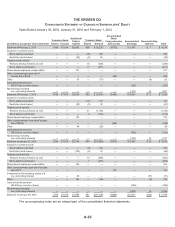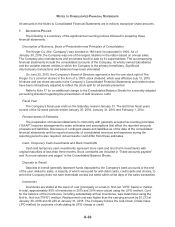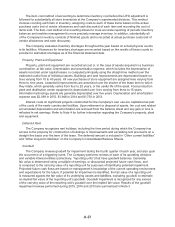Kroger 2015 Annual Report Download - page 101
Download and view the complete annual report
Please find page 101 of the 2015 Kroger annual report below. You can navigate through the pages in the report by either clicking on the pages listed below, or by using the keyword search tool below to find specific information within the annual report.A-27
In addition to the available credit mentioned above, as of January 30, 2016, we had authorized for
issuance $900 million of securities under a shelf registration statement filed with the SEC and effective
on December 13, 2013.
We also maintain surety bonds related primarily to our self-insured workers’ compensation claims.
These bonds are required by most states in which we are self-insured for workers’ compensation and
are placed with predominately third-party insurance providers to insure payment of our obligations in the
event we are unable to meet our claim payment obligations up to our self-insured retention levels. These
bonds do not represent liabilities of ours, as we already have reserves on our books for the claims costs.
Market changes may make the surety bonds more costly and, in some instances, availability of these
bonds may become more limited, which could affect our costs of, or access to, such bonds. Although we
do not believe increased costs or decreased availability would significantly affect our ability to access
these surety bonds, if this does become an issue, we would issue letters of credit, in states where
allowed, against our credit facility to meet the state bonding requirements. This could increase our cost
and decrease the funds available under our credit facility.
We also are contingently liable for leases that have been assigned to various third parties in
connection with facility closings and dispositions. We could be required to satisfy obligations under the
leases if any of the assignees are unable to fulfill their lease obligations. Due to the wide distribution
of our assignments among third parties, and various other remedies available to us, we believe the
likelihood that we will be required to assume a material amount of these obligations is remote. We have
agreed to indemnify certain third-party logistics operators for certain expenses, including pension trust
fund contribution obligations and withdrawal liabilities.
In addition to the above, we enter into various indemnification agreements and take on
indemnification obligations in the ordinary course of business. Such arrangements include indemnities
against third party claims arising out of agreements to provide services to us; indemnities related
to the sale of our securities; indemnities of directors, officers and employees in connection with the
performance of their work; and indemnities of individuals serving as fiduciaries on benefit plans. While
our aggregate indemnification obligation could result in a material liability, we are not aware of any
current matter that could result in a material liability.
OUTLOOK
This discussion and analysis contains certain forward-looking statements about our future
performance. These statements are based on management’s assumptions and beliefs in light of the
information currently available to it. Such statements are indicated by words such as “comfortable,”
“committed,” “will,” “expect,” “goal,” “should,” “intend,” “target,” “believe,” “anticipate,” “plan,” and similar
words or phrases. These forward-looking statements are subject to uncertainties and other factors that
could cause actual results to differ materially.
Statements elsewhere in this report and below regarding our expectations, projections, beliefs,
intentions or strategies are forward-looking statements within the meaning of Section 21E of the
Securities Exchange Act of 1934. While we believe that the statements are accurate, uncertainties
about the general economy, our labor relations, our ability to execute our plans on a timely basis and
other uncertainties described below could cause actual results to differ materially. The guidance below
includes our expectations for Roundy’s.
• We expect net earnings to be $2.19 to $2.28 per diluted share, which is essentially in line with our
long-term net earnings per diluted share growth rate of 8% - 11%. Where we fall within the range will
be primarily driven by actual fuel margins, which we expect to be at or slightly below the five-year
average, with continued volatility. We expect our core business in 2016 to grow in line with our long-
term net earnings per diluted share growth rate of 8% – 11%.
• We expect identical supermarket sales growth, excluding fuel sales, of 2.5%-3.5% in 2016, reflecting
the lower inflationary environment.
• We expect full-year FIFO operating margin in 2016, excluding fuel, to expand slightly compared to
2015 results.


